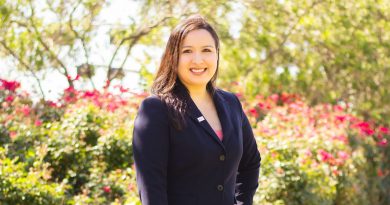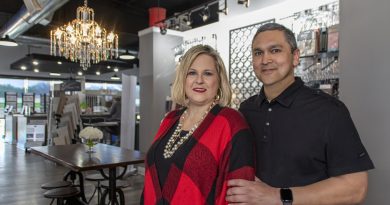Living history of Bell County
Story by Catherine Hosman
Photos by Becky Stinehour
Coleman Hampton loves history.
That passion serves him well as the executive director of the Bell County Museum, a job that allows him to step in and out of the ages from prehistoric times to the 20th century.
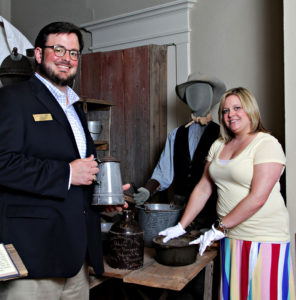
A 2014 graduate of Baylor University with a bachelor’s degree in history, Coleman earned a master’s in museum studies from Baylor in 2016. He thought he would teach history until he met Dr. Ellie Caston, executive director of the Mayborn Museum in Waco, who introduced him to the museum studies program. It captured Coleman’s imagination and made becoming a museum director his goal.
“Now I wanted to work at a museum,” he said. “I worked at the Baylor University Institute for Oral History and volunteered at the Mayborn Museum. I worked jobs that would prepare me to work in a museum.”
As a graduate student Coleman commuted five days a week to the Dallas Heritage Village where he worked as an intern and he gained a broad spectrum of experience.
“I wanted to be a director,” said Coleman, a native Texan who was born in Amarillo and grew up in east Texas.
Coleman worked on a ranch, in an outpatient physical therapy clinic and as a volunteer after high school. “It took me some time to find my calling in life, museum leadership,” he said.
He was named the Bell County Museum director in February 2017. “I feel fortunate to have this position.” Earlier, he was director-curator for the Central Texas Area Museum in Salado.
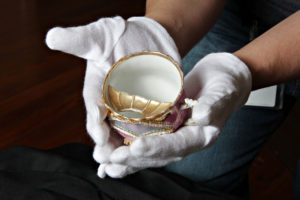
At six-foot-three, Coleman, 35, is towering presence to the Bell County Museum staff and visitors, especially the children.
He said he enjoys the daily variety that comes with being a museum director. “That’s something Dr. Caston talked to me about. Every day is different. It’s challenging that way,” he said. “There are a lot of moving parts with a museum.”
Coleman’s responsibilities range from administration and the preservation of artifacts to working with the education department programs, the budget and marketing. He calls himself a “one-man marketing team.”
“We have a fantastic staff giving visitors the best experience possible,” he said. “I’m working as hard as I can.”
One of his most challenging jobs is to stay on the forefront of museum thought.
“We are a county museum. I do the budget, talk to visitors — I need to keep things flowing smoothly. It’s essential for museum professionals today to be familiar with current thoughts and practices.”
Coleman reads books regularly to see what other museum leaders are doing statewide and nationally. “I need to keep the gears spinning,” he said.
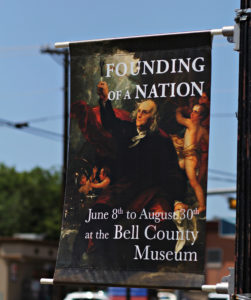
One of the favorite aspects of his job is interacting with visitors and making them feel welcome. “I learn what they like and what it is about the museum they liked best,” he said. “It’s amazing to see the impact in everyone’s life. This is a real special place.”
Keeping up with history
Ask Coleman what is his favorite era in history and you may be surprised by the answer. He cites the mid-20th century as one of the most interesting times of the past.
“It was a great time of change,” he said. “Not just in America. The 1950s and 1960s were a time of rapid growth and profound change. Lyndon Johnson was a Texas senator, who later became president. The Civil Rights Act and Great Society transformed the country and, in a sense, the world. Today’s perception of the 1960s is a decade’s worth of Woodstock and hanging out in San Francisco’s Haight-Ashbury neighborhood. The counter-culture was actually a very small portion of the U.S. population, which is reflected by Nixon’s election by the silent majority. It’s just very interesting to me.”
Another era he gravitates to is 1820 to 1850s Texas. “The Financial Panic of 1819 drove eastern people to Texas land; then there was Texas Revolution from 1835 to 1836.”
Coleman said the Bell County area was, for the longest time, the “westernmost face of the frontier. West of here was not populated. People who came here were rugged.
“The Native American presence was disrupted,” he said. “The Gault Site, an archeology discovery in southern Bell County, was discovered and predates Native American tribes.”
County history and its lessons are important, he said.
“The civilization in this area is astounding. Those stories are inspirational and don’t start with the arrival of Anglo-Saxons. What excites me are the patterns and larger movements from the past, and what we can learn to try and avoid mistakes or pitfalls of the past,” he said. “It strengthens the social fabric of our community when we learn we have a shared history that brings people together.”
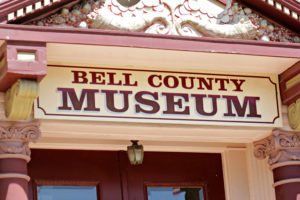 Keeping history alive
Keeping history alive
Coleman wants to see the museum grow and continue to make a positive impact on the community.
“Coleman has the experience so that he hit the ground running when he came on board,” said Bell County Museum Board Chair Dennis Turk. “He is basically the originator of some of the (recent) programs at our museum like the spring lecture series that I hope goes on for a lot of years. We have access to expertise and talents you don’t normally see in a museum.”
“We are finding community partners,” Coleman said, “and we are proud of the schools in our community and the services we provide them.”
“There is a staff person directed at education and we very much value the approach we make to the schools,” Turk added. “We take trunk exhibits to schools and schools come to the museum.”
In addition to the traveling trunks, where museum volunteers bring educational resources to the children, the museum also offers a $50 bus grant to schools to encourage field trips.
“The museum has a talented staff dedicated to the schools: homeschooling, public, charter. They present programs that are tailored in content for the children,” said David Yeilding, PhD, professor emeritus of History. “We have programs all year round for kiddoes. Large numbers of them come to the museum and become acquainted very early in life with the Bell County Museum, and their parents will become aware of it.”
Coleman said his leadership style is not to impose his will on others. “It’s more about listening to what people want. It’s the same for the trustees and staff. We are here to be a resource for the community and provide what the community wants,” he said.
“Coleman is a personable individual and he makes a wonderful presentation,” said Yeilding, who calls Coleman the face of the museum. “When he gives programs he is very smooth, very accomplished.”
The museum includes a staff of four people. But it’s the army of volunteers, including veterans, which help with the educational programs on the weekends, set up exhibits, and create murals like the one in the current “Founding of a Nation” exhibit.
“We couldn’t do what we do without the volunteers,” Coleman said.
There are 20 to 30 regular volunteers and a catalogue of others who work at the museum. “It’s uncommon to see this many active volunteers in a museum our size,” he said. “It speaks to the county and the type of people who live here.”
Coleman said it’s the dedication of the museum board, county commissioners, judges and previous director Stephanie Turnham that have built the Bell County Museum.
“I feel like I’m standing on the shoulders of great people,” he said. “This has been an exceptional museum for a long time.”



